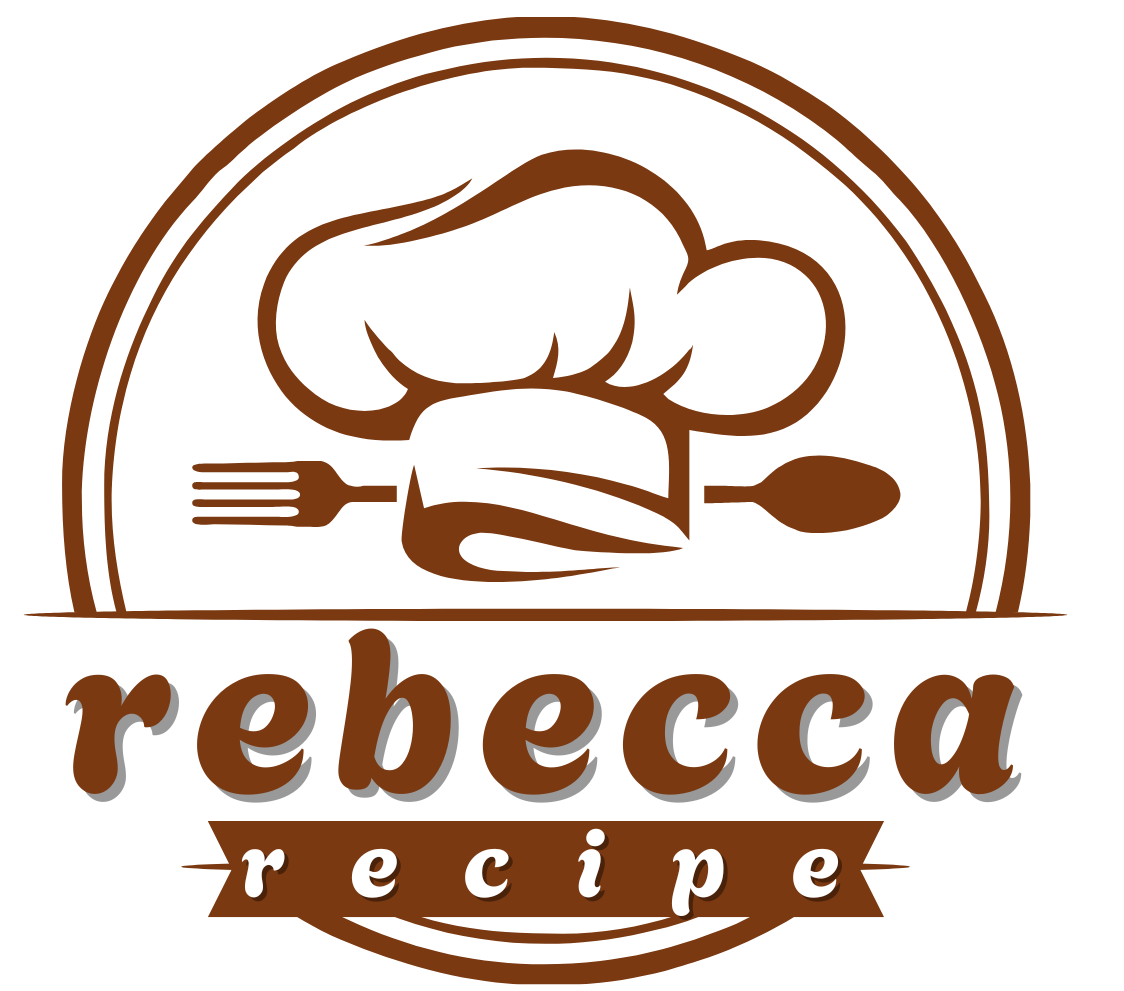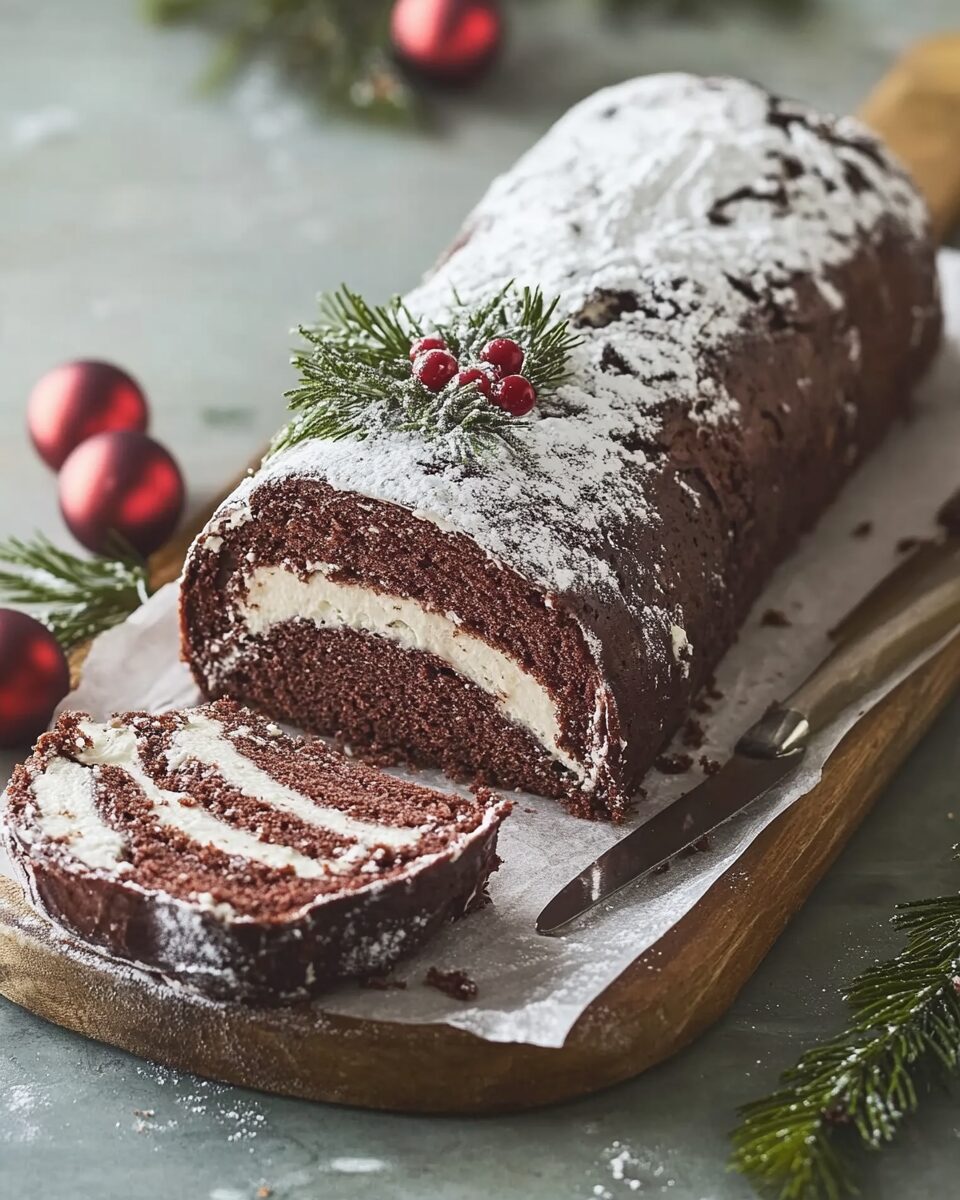Bûche de Noël, or Yule Log, is a traditional French dessert that resembles a festive log. This rich chocolate sponge cake is filled with sweetened whipped cream, rolled into a log shape, and covered in chocolate ganache, making it a show-stopping centerpiece for holiday celebrations.
Full Recipe:
Ingredients
For the Filling:
- 2 cups heavy cream
- ½ cup confectioners’ sugar
- ½ cup unsweetened cocoa powder
- 1 teaspoon vanilla extract
For the Cake:
- 6 egg yolks
- ½ cup white sugar
- ⅓ cup unsweetened cocoa powder
- 1½ teaspoons vanilla extract
- ⅛ teaspoon salt
- 6 egg whites
- ¼ cup white sugar
For Dusting:
-
Confectioners’ sugar
Directions
-
Prepare the Filling: In a large bowl, whip together heavy cream, confectioners’ sugar, cocoa powder, and vanilla extract until thick and stiff. Refrigerate until needed.
-
Preheat Oven: Set the oven to 375°F (190°C). Line a 10×15-inch jellyroll pan with parchment paper.
-
Mix Egg Yolks: In a large bowl, beat egg yolks with sugar until the mixture is thick and pale. Blend in cocoa powder, vanilla extract, and salt.
-
Beat Egg Whites: In a separate bowl, beat egg whites until soft peaks form. Gradually add sugar, continuing to beat until stiff peaks form.
-
Combine Mixtures: Gently fold the egg yolk mixture into the egg whites until well combined.
-
Bake the Cake: Spread the batter evenly into the prepared pan. Bake for 12 to 15 minutes, or until the cake springs back when lightly touched.
-
Roll the Cake: Dust a clean dish towel with confectioners’ sugar. Upon removing the cake from the oven, immediately invert it onto the towel. Peel off the parchment paper. Starting from one short edge, roll the cake and towel together into a tight spiral. Allow it to cool completely.
-
Assemble the Bûche de Noël: Once cooled, unroll the cake and spread the filling evenly over the surface. Roll the cake back up without the towel. Place it seam-side down on a serving platter.
-
Decorate: Dust the cake with confectioners’ sugar to resemble a snow-covered log. Garnish with meringue mushrooms or holly sprigs if desired.
Nutrients
- Calories: 340 kcal
- Total Fat: 22g
- Saturated Fat: 13g
- Cholesterol: 175mg
- Sodium: 80mg
- Total Carbohydrates: 30g
- Dietary Fiber: 2g
- Sugars: 25g
- Protein: 7g
Historical Origins
The origins of the Bûche de Noël can be traced back to ancient European winter solstice celebrations. During these times, families would burn a large log in the hearth, a practice believed to bring warmth and good fortune for the coming year. This ritual, prevalent among the Celts and other pagan communities, symbolized the welcoming of longer days and the hope for a prosperous harvest. As Christianity spread across Europe, the tradition of the Yule log was assimilated into Christmas celebrations, maintaining its essence of fostering family unity and warding off misfortune.
By the 19th century, as large hearths became less common and smaller stoves gained popularity, the practice of burning an actual Yule log diminished. French pâtissiers ingeniously transformed this tradition into an edible centerpiece, crafting a cake that mimicked the appearance of the festive log. This culinary adaptation not only preserved the symbolic essence of the Yule log but also introduced a delightful dessert to holiday feasts.
Cultural Significance
In France, the Bûche de Noël holds a place of honor in Christmas celebrations. Serving this cake during the réveillon, the traditional Christmas Eve feast, signifies the culmination of the meal and embodies the spirit of togetherness. The act of preparing and sharing the Bûche de Noël fosters familial bonds and serves as a testament to the importance of culinary traditions in cultural identity.
Beyond France, the Bûche de Noël has found its way into the holiday customs of various countries, including Belgium, Switzerland, Canada, and regions influenced by French culture. Its widespread adoption underscores the universal appeal of traditions that celebrate warmth, family, and festivity during the holiday season.
Traditional Preparation and Presentation
The classic Bûche de Noël is a roulade, consisting of a light sponge cake filled with buttercream, rolled into a cylinder, and coated with chocolate or coffee-flavored icing. The exterior is artfully textured to resemble tree bark, often achieved by running a fork through the icing. Dustings of powdered sugar emulate freshly fallen snow, enhancing the log’s realistic appearance.
Decorative elements play a significant role in the presentation of the Bûche de Noël. Confectioners often adorn the cake with meringue mushrooms, sugared holly leaves, berries, and other edible embellishments that evoke a woodland scene. These artistic touches not only elevate the visual appeal of the dessert but also pay homage to the natural elements associated with the original Yule log tradition.
Variations and Modern Interpretations
While the traditional Bûche de Noël remains beloved, contemporary pastry chefs have embraced innovation, introducing a plethora of variations that cater to diverse palates and aesthetic preferences. Some notable adaptations include:
-
Flavor Diversification: Beyond the classic chocolate and coffee flavors, modern Bûches de Noël feature fillings and icings infused with fruits like raspberry, passion fruit, and citrus, as well as exotic ingredients such as matcha and praline.
-
Textural Innovations: Chefs experiment with different cake bases, incorporating elements like dacquoise or biscuit joconde, and varying fillings, including mousses, ganaches, and fruit compotes, to create multi-textured experiences.
-
Aesthetic Redesigns: Departing from the traditional log shape, some interpretations present the Bûche de Noël as individual servings, geometric forms, or minimalist designs, reflecting contemporary culinary artistry.
These modern takes on the Bûche de Noël demonstrate the dessert’s adaptability and the dynamic nature of culinary traditions, allowing each generation to imprint its creativity while honoring the essence of the original confection.
Nutritional Considerations
As a rich dessert, the Bûche de Noël is typically high in calories, sugars, and fats, primarily due to ingredients like butter, sugar, and chocolate. A standard serving can range between 300 to 400 calories, with variations depending on specific recipes and portion sizes.
For those mindful of dietary intake, several strategies can be employed to create a lighter version of the Bûche de Noël:
-
Ingredient Substitutions: Utilizing whole grain flours, reducing sugar quantities, and incorporating healthier fats can enhance the nutritional profile without compromising taste.
-
Portion Control: Serving smaller slices allows guests to indulge in the festive treat while maintaining moderation.
-
Alternative Fillings and Icings: Replacing traditional buttercream with options like Greek yogurt-based fillings or fruit purées can reduce fat content and add nutritional value.
By adopting these approaches, the Bûche de Noël can be enjoyed as a delightful conclusion to holiday meals while aligning with health-conscious considerations.
Tips for Crafting the Perfect Bûche de Noël
Creating a Bûche de Noël is a rewarding endeavor that combines baking skills with artistic expression. To achieve a successful and impressive dessert, consider the following tips:
-
Sponge Cake Mastery: Aim for a light and flexible sponge to facilitate easy rolling without cracking. Achieving the right consistency involves proper aeration of the batter and precise baking time.
-
Even Filling Distribution: Spread the filling uniformly to ensure a balanced flavor profile in every slice. Avoid overfilling, which can lead to spillage during rolling.
-
Chilling for Stability: After assembling the roll, refrigerate it to set the shape and firm up the filling, making the final icing process more manageable.
-
Artful Decoration: Embrace creativity in decorating the log, using tools to create bark-like textures and adding festive embellishments that enhance the visual appeal.
By adhering to these practices, both novice and experienced bakers can create a Bûche de Noël that not only delights the palate but also captivates the eyes.
Symbolism and Celebration
The Bûche de Noël represents more than just dessert—it embodies centuries of tradition, the warmth of family gatherings, and the joy of creative culinary expression. In many households, baking the Yule Log is a cherished activity that brings generations together, often involving children in the decoration process and adults in passing down family recipes.
Its symbolism remains deeply rooted in hope, renewal, and festivity. Just as the ancient Yule log was meant to light the darkest days of winter and bless the home with prosperity, the modern cake version carries with it a similar spirit of optimism and celebration. Sharing a slice is not merely the end of a meal but a ritual of joy and togetherness.
Conclusion
The Bûche de Noël is a masterpiece of tradition, artistry, and flavor. From its roots in ancient solstice rituals to its place at modern holiday tables, this dessert has stood the test of time. It blends history with modernity, offering an opportunity to honor the past while embracing creativity.

